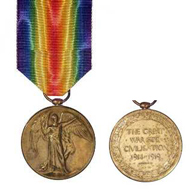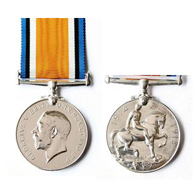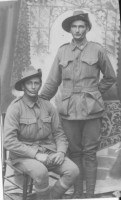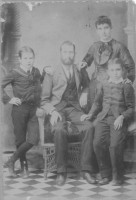WRIGHT Bertie Trantie William "Bill"
-

- 4930
- Corporal
- 15 Battalion
- Woombye
- Yes
- 7 January 1894
- Brisbane, Queensland
- 13 September 1915
- HMAT A73 Commonwealth
- 28 March 1916
- Brisbane
-
Family
Eli Wright was born in 1855 in England. He married Ann Maria Whitehouse in West Bromwich district, Staffordshire, in 1879. They had one child of their own, Eli John Wright (born in 1880), but raised two other boys, one of whom was certainly fostered formally.
The English family of three emigrated from Plymouth aboard the “Roma”, and they arrived at Brisbane on 17 November 1882. They would establish on the Sunshine Coast. A studio photograph of Eli and Ann and two boys aged about 10 (refer Gallery), suggests they fostered their first child in the first decade after their arrival. The boy known in the family as “Aaron” is not recorded in Queensland birth records. He suffered a degree of mental incapacity and, since the name “Aaron Wright” cannot be found in Queensland records, he was probably not given the Wright family name. Sometime after Eli's and Ann's death in 1928, he was committed in turn to the Dunwich Benevolent Asylum and the Eventide Home at Sandgate where he died.
Of their formally fostered son, rather more is known. If Albert James Tranter’s declaration of his age at enlistment in 1915 was accurate and the recruiting officer correctly calculated his age in years, months and days, his birthdate was 1 February 1894. Throughout his life, however, Albert celebrated his birthday on 7 January. His mother was Eliza Ann Tranter, a young immigrant English woman, probably no more than 18 when her son was born. The registration of his birth on 21 February 1894 would record no father’s identity. Eliza delivered her baby son into the care of the Salvation Army in early 1894 and then promptly disappeared from both his life and the public record. She would have been proud of her son’s achievements from such humble beginnings.
In March 1895, the Salvation Army began the process of placing Albert in the foster care of Eli and Ann Wright. The attachment was formalised on 30 June 1895. Eli and Ann gave the little boy the name Bertie Trantie William Wright which was the name he provided at his enlistment in 1915. The family called him “Willie” but he was “Bill” to everyone else. He was never formally adopted.
As a fifteen year old boy, Bill joined the Druids’ Lodge in Nambour. It was a Friendly Society that covered medical, pharmacy and general expenses. He retained membership throughout his life.
Eli John Wright, the closest that William would know of a brother, married Harriet Wright on 18 December 1915. Bill had already been training in the A.I.F. for three months.
In the Queensland Electoral Rolls of 1903 to 1919, Eli and Ann and their son Eli were recorded at Woombye. Eli Snr. was a “farmer” and Eli Jnr. a “labourer”. Eli Jnr. was already suffering the effects of tuberculosis which would soon claim his life.
Military Context
The 15th Battalion was raised six weeks after the outbreak of the First World War. Three-quarters of the battalion were recruited as volunteers from Queensland, and the rest from Tasmania. With the 13th, 14th, and 16th Battalions it formed the 4th Brigade, commanded by Colonel John Monash.
The 4th Brigade landed at Anzac Cove late in the afternoon of 25 April 1915. The 15th Battalion fought at Anzac and in the August offensive at Sari Bair. After evacuation from Gallipoli and return to Egypt in December, the 15th Battalion was split and provided experienced soldiers for the 47th Battalion. It always held special attachment to men of the 15th .The 4th Brigade was combined with the 12th and 13th Brigades to form the 4th Australian Division. In June 1916, they sailed for France and the Western Front.
Its first major action in France was at Pozieres in August. Along with most of the 4th Brigade, the battalion suffered heavy losses at Bullecourt in April 1917. It spent much of the remainder of 1917 in Belgium, advancing to the Hindenburg Line. Its Battle Honours that year included Messines, Third Battle of Ypres (Passchendaele) and Polygon Wood.
In March and April 1918, the battalion helped stop the German spring offensive. The battalion participated in the great allied offensive of 1918, fighting near Amiens on 8 August. This advance by British and empire troops was the greatest success in a single day on the Western Front and prompted General Erich Ludendorff to describe it as “the blackest day of the German army in this war”. The battalion continued operations until late September 1918.
Enlistment
Bertie Trantie William Wright enlisted at Brisbane on 13th September 1915. His age was declared precisely, if not accurately, as 21 years 8 months 12 days and his occupation “labourer”. He was 5 feet 8 inches in height, weighed 143 pounds, of dark complexion, with hazel eyes and black hair. His religion was Methodist. He recorded his mother Mrs. E. Wright at Spond Farm, Woombye as his next of kin. He allocated not less than four-fifths of his Army pay to his foster mother (he honoured the commitment fastidiously). His Service Number was 4930.
Bill and his mates from Woombye enlisted just at the end of the football season. They had won the local premiership and needed to explain at the Recruitment Station that the black eyes were the result of a tough football season, not settling arguments in the street.
The “Chronicle and North Coast Advertiser” reported on the 1 October that he, Fred and Percy Pringle would go into camp at Brisbane that day.
All three would serve with the 15th Battalion. Two would be awarded the Military Medal, and one would spend eighteen months in a German prisoner of war camp.
The Gallery includes a photograph of Bill Wright (seated) and Fred Moore (standing), both from Woombye. Fred, serving with 26th Battalion, would be killed in action in France in March 1917, one month before his three Woombye friends went into action at Bullecourt.
Military service
Private Bill Wright was assigned to the 15th Reinforcements of the 15th Battalion. On 28 March 1916, he departed from Brisbane aboard HMAT A73 “Commonwealth” bound for Egypt. With him were his Woombye mates Percy and Fred Pringle. They disembarked in Egypt on 5 May.
Three months later to the day, Private Bill Wright embarked upon the SS “Megantic” for England and service with the British Expeditionary Force in Europe. He was marched in to the 4th Training Battalion at Codford, Wiltshire.
On 30 September 1916, he proceeded via Southampton to the 4th Australian Division Base Depot at Etaples. He was taken on strength of the 15th Battalion in the field on 16 October. The winter had begun in earnest and the men were heavily reliant on the sheepskin jackets, cardigans, balaclavas and mittens only recently issued.
He fought with the battalion through the balance of 1916 and then at Gueudecourt and Lagnicourt, and at Bullecourt in April 1917. Bullecourt was a military disaster because the infantry was ordered to attack the Hindenburg Line without the spearhead of tanks which had been a critical element of the original plan for the assault. The Australian 4th Brigade was rendered an ineffective fighting force for many months to come.
Unlike most others, Bill Wright and Percy Pringle survived Bullecourt without physical wounding, but Fred Pringle was wounded and taken prisoner. He would wait for the end of the War in Dulmen prisoner of war camp, Westphalia, Germany.
The year 1917 was to be one of almost endless battle. The sound of guns had barely subsided at Bullecourt when the Australians were sent to take part in the great series of battles that began with Messines and ended with the Third Battle of Ypres (Passchendaele).
Private Wright was promoted to Lance Corporal on 10 September 1917, but he would have to wait another nine months for full Corporal and the 70% pay rise that accompanied the promotion.
Gallantry in Action
The 4th Australian Brigade was committed towards the end of September in the Battle of Polygon Wood. The position to be assaulted was just short of Broodseinde Ridge near Zonnebeke village, Belgium. The distance to be covered was about 1000 yards. The country ahead was pockmarked with shell holes and was a sea of mud. The 15th Battalion was, at this time, the strongest in the Division – 22 officers and 750 other ranks. On 25 September, it departed its encampment on the Ypres Ramparts only when the moon set so it could advance with less chance of detection by the German defences. With allied artillery pouring a savage barrage into the German lines, the infantry advanced towards the railway line at Zonnebeke. The intended final Australian objective was the eastern outskirts of the village facing Broodseinde. The action, which commenced in relative quiet, unfolded progressively in the face of German artillery which, either on suspicion of attack or actual intelligence, began to shell back areas after about 4.15am on 26 September.
On 1 October 1917, Lieutenant Colonel Terry McSharry who commanded 15th Battalion (himself a decorated officer who would die of wounds in France in August 1918) was moved to commend Lance Corporal Wright formally: “For conspicuous gallantry and devotion to duty while in action near Zonnebeke on 26th September 1917. This N.C.O. handled his Lewis Gun with great skill and daring. As soon as the objective was gained, he got his gun forward to cover the consolidation, and from this position was able to silence an enemy machine gun which was harassing the work of consolidation. He worked with great dash throughout the operation and was always cool and collected.”
McSharry’s recommendation for the award of the Military Medal was endorsed by Major-General Sinclair Maclagan, commander the 4th Australian Division. The Military Medal was actually conferred on 31 October and, on 14 November General Maclagan sent a pro forma of his personal congratulations to the soldier. Unsurprisingly, it has been retained in the family to this day as a very special symbol of recognition.
On 30 May 1918, Mrs. Wright at Spond Farm, Woombye, North Coast Line, received a letter from Base Records. It read: ”I have much pleasure in forwarding an Extract from the Third Supplement No. 30431 of the “London Gazette” dated 14th December 1917. His Majesty the King has been graciously moved to approve of the award of the Military Medal for bravery in the field to the undermentioned No. 4930 Private (Lance Corporal) B.W. Wright. The above has been promulgated in the Commonwealth of Australia Gazette No.66, dated 2nd May, 1918.”
Continuing service in Europe
On 4 July 1918, Bill Wright fought with his Digger mates at the Battle of Hamel. Here, his best mate Percy Pringle’s gallant action was recommended for the award of the Military Medal.
Bill Wright M.M. was promoted to Corporal on 20 July 1918. From that date, his daily rate of pay increased from 5 shillings to 8 shillings and 6 pence.
Bill Wright and Percy Pringle fought at Amiens on 8 August. Percy's conduct saw a Bar added to his Military Medal. Percy was no ordinary soldier (his comrades in arms even accorded him no small part in the circumstances at Hamel which saw Henry Dalziell awarded 15th Battalion's only Victoria Cross).
On 23 August, Bill Wright was detached to the Australian Corps School for one month. After returning to his unit for one week, he was granted leave to the United Kingdom. He was back with his unit on 15 October. The War had less than one month to run to Armistice. The Gallery includes a photograph taken on 28 December 1918 of the Lewis Gun Platoon. Bill Wright is in the front row, second from right.
Return to Australia
On 10 February 1919, Corporal Bill Wright left France for the last time. On 13 April 1919, he embarked at London for his return to Australia on HMAT A73 “Commonwealth”, the same ship which had taken him from Brisbane to Egypt in 1916. He disembarked at Sydney on 12 June. He was discharged from the A.I.F. at Brisbane on 28 July 1919. He had been a generous contributor to his foster mother’s financial welfare during his service. She was advanced the lion’s share of the total remuneration of 511 pounds 13 shillings and 6 pence he received for his 1411 days of military service.
After the War
Bill Wright M.M. was issued the British War medal and the Victory medal.
Eli Wright Jnr., aged only 41 years, and father of three, died in 1922 of tuberculosis. He was buried in Woombye cemetery.
Bill Wright married Nettie May Paterson on 11 April 1925 in Woombye Methodist church (coincidentally, it was the 8th anniversary of the First Battle of Bullecourt). The description of the wedding was carried by the “Nambour Chronicle and North Coast Advertiser” on 17 April. Percy Pringle, who had enlisted and served with William in the 15th Battalion, acted as best man and Percy's fiancée acted as the second witness. Bill reciprocated the favour as best man for Percy when he married Hilda McClintock two months later.
Bill worked as a saw miller and felled scrub in the Mary Valley, but his full story after the war is covered more comprehensively in concluding paragraphs written by his son Jim.
Eli Wright Snr., filling the role of the father Bill never knew, died on 15 May 1928. He was aged 73 years. His widow Ann Maria (nee Whitehouse) barely survived him. She died on 14 August, aged 71 years. Both were buried in Woombye cemetery. The Wright land at Kiel Mountain Road, Woombye, passed to Harriet, the widow of their deceased son Eli. Her son, John Henry Wright, managed the farm when his mother moved to Maroochydore and ultimately inherited it.
Bill Wright made his own way in the world. He had bought 12 acres of uncleared land from his father-in-law, Walter Paterson. The man gifted another 5 acres as a wedding present.
In the Electoral Rolls from 1925 to 1949, Bill and Nettie were recorded at Woombye. William’s occupation was “labourer”. Their children, Jessie Bernice and James William, were born on 3 December 1928 and 15 January 1939 respectively. Bill Wright and Percy Pringle worked together for many years on the Woombye Fruit exhibit at the Brisbane RNA Show. The annual reunion of 15th Battalion was always held in Show week. The inaugural reunion had been held in 1929.
In 1935, the Angels’ Remembrance Club was formed. Bill was a member. Its objectives were to perpetuate the tradition of 15th Battalion, to perpetuate the memory of deceased comrades, and to promote good fellowship amongst surviving members of 15th Battalion and ex-members of other battalions for whom specific provisions were made. Its activities were described by Lieutenant Chataway in his book – “History of the 15th Battalion A.I.F. 1914-1918”. In the book, Bill’s mate, Percy Pringle M.M., is pictured in the battalion’s rugby team of 1918 and leading the battalion in the 1945 Anzac Day March in Brisbane.
In 1937, Bill and Nettie took responsibility for seven year old Marjorie Louise de Lort. She was a ward of the State Childrens’ Department. She was fostered by the Wright family and raised to adulthood.
In the Electoral Roll of 1954, Bill and Nettie were recorded at Eudlo Rd., Palmwoods. William’s occupation was “farmer”. Their daughter, Jessie, “home duties”, was living with them.
In 1958, the same three people were recorded at 30 Fairmeadows Rd., Nambour. On 2 January 1959, the Base Records Office in Melbourne was advised by the Department of Repatriation that Bill Wright had made application for Repatriation Benefits and the Department was seeking confirmation of his War service record.
In the Electoral Rolls of 1963 and 1968, Bill and Nettie were still living at Fairmeadows Rd., Nambour.
Albert James Tranter a.k.a. Bertie Trantie William Wright M.M., ex-A.I.F., pensioner, aged 77 years, died on 28 May 1971 in Nambour Hospital. The cause of death was “cerebral haemorrhage (3 days) and cerebral arteriosclerosis”. The personal information on the Certificate was provided by his son James Wright, then residing at 23 Haren St., Mareeba. Bill Wright was buried next day in the Nambour Gardens Lawn Cemetery, in a service conducted by Methodist minister Ron Elvery.
William’s widow, Nettie May, continued to reside in her Fairmeadows Road home until her death on 25 March 1981. She too was buried in the Nambour Gardens Lawn Cemetery.
James “Jim” Wright Remembers
Jim Wright and his wife Joan visited the battlefields of Gallipoli, France and Belgium in 1999.
At his sister’s funeral in Nambour in May 2002, Jim realized how little Jessie’s children and grandchildren knew of their forebears. He set out to remedy the situation. His recollections included here tell his father’s story simply but eloquently.
“Dad was born in Brisbane on 7 January 1894 and was the illegitimate child of Eliza Ann Tranter who was born in Shropshire, England. She gave her age as 20 years (see below). No father’s name was given when the birth was registered. Dad’s name on the birth certificate was given as Albert James Tranter.
The Salvation Army took him and his mother disappeared. I have tried to track her down – when she married, died etc. but there is no record of any marriage or death in Queensland and possibly NSW and Victoria. Eliza left documents with the Salvation Army in Brisbane and these were sent to Dad on 18 July 1921 along with a letter saying that Eliza was admitted to the Salvation Army hospital on 3 August 1893 when she was 17 years old, not 20. They could not give any details as to where she went when she left the hospital. I have the letter but not the documents. I don’t know what they were or what happened to them.
Eli and Maria Wright of Kiels Mountain, Woombye signed an agreement with the Salvation Army to bring Dad up. I don’t know the exact date but it was between 22 March 1895 and 30 June 1895 that the Wrights took Dad under their control. He was given the name Bertie Trantie William Wright. So we are not related to any of the Wrights !
Dad went to Woombye School. His first job was as a horse boy with Jimmy Alford who had horse teams. He worked at various labouring jobs until he enlisted in the A.I.F. on 13 September 1915 in Brisbane. He was sent overseas on 28 March 1916. After training in Egypt and England, he was sent to France on 16 October 1916 and was taken on strength of the 15th Battalion, 4th Brigade, 4th Division, A.I.F.
He served in France and Belgium with this unit and was awarded the Military Medal for conspicuous gallantry and devotion to duty while in action near Zonnbecke, Belgium on 26 September 1917. He finished the war with the rank of Corporal and returned home to Australia on 13 June 1919 and was discharged from the army on 28 July 1919.
Following the war, he worked in Bartholomew’s sawmill in Woombye as a tailor/out. He also felled scrub in the Mary Valley. He was injured playing football in 1920 and spent six months in hospital in Brisbane with a detached Achilles tendon and ended up signing himself out of hospital. He wore a calliper on that leg for several years until it came good.
He married Nettie May Paterson (Mum) on 11 April 1925 in the Methodist church in Woombye. They lived on 17 acres on Kiels Mountain Road, Woombye which was part of the original selection in 1885 by Walter Paterson (Snr.). Dad bought 12 acres at $20 per acre on 31 May 1922 from Walter Paterson (Jnr.) who was Mum’s father. The balance of 5 acres was given to them as a wedding present. They built a house and lived here and grew pineapples and oranges until December 1944 when they sold to Joe Tescke and moved to “Riverview” on the Maroochy River at Maroochydore.
In 1942 when it was commonly thought that the Japanese would invade Australia, Mum, Jessie, Marjorie and myself and a friend of Mum’s Bunny Rutherford and her daughters Nancy and Glenda went to live on the Hamilton family property “Jolimont” north east of Jandowae. We lived in the “Old Jolimont” house for six months while Dad stayed behind and ran the farm at Woombye. Once the invasion threat was over we went home to the farm. Dad joined the V.D.C. (Volunteer Defence Corp), Australia’s equivalent to Britain’s “Dad’s Army”, during the war and served as a Private in the local unit.
Dad was self employed while at Woombye and Maroochydore cutting timber for posts, palings, house stumps etc. He also worked for farmers and others. After the war, he bought a farm from Jimmy Wordie at Rosemount Road, Nambour and grew pineapples and bananas. Mum and Dad never lived on this farm and it was sold.
Mum had “Riverview” converted into two flats in December 1948. Only one of these flats was rented until April 1949, because we were still living in the other one. It only became available when we moved to the farm at Glasshouse Mountains. In April 1949, Dad bought Bill Tyler’s farm at Glasshouse Mountains. He grew pineapples and oranges and did very well as it was a good farm and he was a good farmer. He sold it in December 1952 to Owen Brothers because they offered him such a good price that he could not refuse. He then bought another farm at Glasshouse Mountains from Bill McClintock and grew pineapples. This farm was sold in 1953, just prior to a major slump in the pineapple industry.
He then bought a few acres east of the railway station at Palmwoods. He worked for Briggs and as a greenkeeper at the Palmwoods Lawn Bowls club. Dad sold this property to Bulls in 1955. He then bought the house at 30 Fairmeadows Road, Nambour. He worked for farmers and finally worked as a cleaner at Nambour High School until he retired. Dad died from a stroke on 28 May 1971 and is buried in the Nambour Garden cemetery.”
Researcher’s note – It is indeed a small world. The “Jolimont” property at Jandowae where the Wright family sought refuge from possible Japanese invasion in WW2 adjoins the “Kurrajong” and “Dixie” grazing properties which were bought by me seven years ago for beef cattle breeding.
-
- Amiens
- Bullecourt
- Hindenburg Line
- Messines
- Polygon Wood
- Western Front
- Ypres
-

-

-

- Returned to Australia
- 12 June 1919
- 28 May 1971
- Nambour, Queensland
- 77 years 4 months
- Nambour Gardens Lawn Cemetery
-
Woombye Roll of Honour, Woombye School of Arts Hall, Blackall Street, Woombye (as W Wright)
Woombye War Memorial, Memorial Park, Blackall Street, Woombye (as B F Wright)
Nambour (Maroochy Shire) Roll of Honor Scroll, Private Collection, Nambour (this scroll was available for sale to the public after the war) (as W Wright)
"Wall of Remembrance" Quota memorial Park, Nambour
United Ancient Order of Druids (U.A.O.D.) (Nambour) Honour Board (Chronicle) whereabouts unknown
-
Australian War Memorial
National Australia Archives
Ancestry.com
Trove digitised newspapers
Queensland Death Certificate registration number 1971/11854
"History of the 15th Battalion AIF 1914-1918" by Lieutenant T.P. Chataway
The personal contribution of Mr. Jim Wright, son of the serviceman, was critical to the accuracy of the information in this record and is very gratefully acknowledged. Jim's detail was such that his special contribution is included in its own right at the conclusion of the biography. He was also the source of the photographs.
- Grant Thorne



